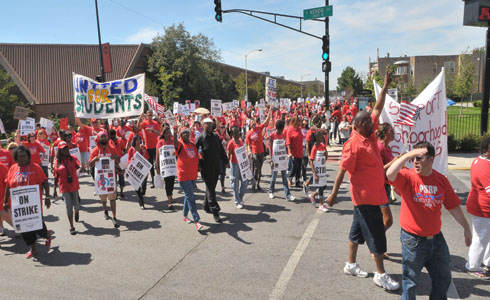
A sea of red could be seen Wednesday in front of Marshall High School and on the surrounding blocks on the West Side as teachers marched with picket signs on the third day of the Chicago Teachers Union strike.
Supporters of the first CTU strike in 25 years joined teachers representing several schools –– including Orr, Farragut, Crane and Al Raby –– as they took over Madison Street, Homan and Kedzie avenues and Jackson Boulevard.
As you ride along the expressways you can see teachers standing on the bridges waving their signs to acknowledge the honking horns in support of the strike.
Nearly 400,000 public school students are affected by the strike.
Mayor Rahm Emanuel called the strike one of “choice” and hasn’t backed down from the statement. He wants contract negotiations with teachers to continue with students in class.
Board President David Vitale, the lead schools negotiator, said early in the day that a deal could be reached, but union President Karen Lewis and her colleagues emerged from the talks accusing the board of having dug in its heels with its new proposal. Among the biggest remaining issues are a new teacher evaluation system and a process for deciding which laid-off teachers can be rehired.
“There’s been — let’s put it this way — centimeters (of progress) and we’re still kilometers apart,” said Lewis, who earlier stated it was “lunacy” to think the issues could be wrapped up quickly.
Here is a breakdown of the issues on the table:
TEACHER EVALUATIONS: The union is particularly concerned about a new teacher evaluation system, arguing it would be unfair because it relies too heavily on students’ standardized test scores and does not take into account external factors that affect performance, including poverty, violence and homelessness. They argue it could result in 6,000 teachers losing their jobs within two years. The district says the union already agreed to the new evaluation system, but it has offered to make adjustments.
JOB SECURITY: Worried about dozens of schools that could be closed in the next few years, the union has pushed for a policy to recall laid-off teachers when jobs open up anywhere in the district. The district says that could force principals to hire teachers they don’t believe are qualified. Instead, it has said that if a school closes, teachers would have the first right to jobs that match their qualifications at the schools that absorb the children from the closed school. It also offered to put them in a reassigned teacher pool for five months or give them a three-month severance package.
SALARY and BENEFITS: The school district has offered a 16 percent raise over four years — double an 8 percent offer made earlier — as well as “modified step increases” that it says reward experience and provide “better incentives for mid-career teachers” to keep them from leaving. The district also wants to do away with the ability of teachers to bank sick days but is offering short-term disability, including paid maternity leave. Chicago teachers are among the highest-paid in the nation. Their average salary is $76,000, according to the school district.
LONGER SCHOOL DAY: This central issue appeared to be solved after the two sides agreed weeks ago to a plan allowing the hiring of nearly 500 teachers to cover a longer school day without forcing teachers to work longer. But union officials remain angry about how Emanuel tried to go around them to get the longer day in place early, including offering incentives to individual schools. Union President Karen Lewis has complained about how the longer day is being implemented.
Ald. Roderick Sawyer (6th) said it’s time to tone “down the rhetoric.”
“In my time in this office I have seen many hardworking and dedicated teachers and I have met many hardworking members of CPS administration. Both sides would do better if we toned down the rhetoric. However, I must acknowledge that the teachers union has a history of being burned, as with the rescinded pay increase, and I do not understand how the city did not engage the teachers as soon as there was a 90 percent strike authorization vote. As this becomes more of a debate about whether teachers are greedy or whether the Mayor wants to privatize schools, the children are the ones who lose,” said Sawyer.
The Rev. Jesse Jackson urged for a swift end to the strike.
“We realize that there are a number of issues that remain unresolved, including the implementation of the state-mandated Performance Reform Evaluation Act passed in 2011, and standards for student and teacher evaluation. The State of Illinois has a role in these negotiations and should therefore have a representative in the room,” the reverand said.
Jackson was not alone. A group of pastors from around the city called for the “shortest” strike in history.
Bishop Larry Trotter of Sweet Holy Spirit on the South Side said both sides need to come together quickly to find a resolution and get the students back in the classrooms.
Trotter, flanked by other faith-based leaders, said parents worried all summer about the safety of their children during continuous days of gun violence throughout the city while school was on break. With the “break” extended by the strike, the worrying continues.
“The parents now have to worry about the kids staying safe during a time they’d normally be in school,” said Trotter.
Porchia Sims said it’s frustrating to see the teachers on strike because her daughter likes going to school. In the meantime, she’ll continue to play her part and spend the time her daughter Shariya would be in school doing educational things with her.
School officials also took steps to prepare for a long haul, despite persistent assertions by Emanuel and others that the strike was “unnecessary” and could be resolved quickly. The school district in the country’s third largest city announced that, beginning Thursday, the 147 Children First drop-off centers where students can get free breakfast and a morning of supervision will be open six hours a day rather than four.
The drop-off centers, or “hubs,” are manned by CPS administrators and can collectively hold 150,000 students. All male principals are serving as security support at each hub. More than 25,000 students are signed up to attend the sites during the strike.
Chicago Public Schools Chief Executive Officer Jean-Claude Brizard is expected to participate in a principal roundtable discussion Wednesday at Clemente High School to discuss critical issues at the negotiation table, such as teacher evaluations and teacher recall.
Associated Press contributed to this story
(Defender/Worsom Robinson)


